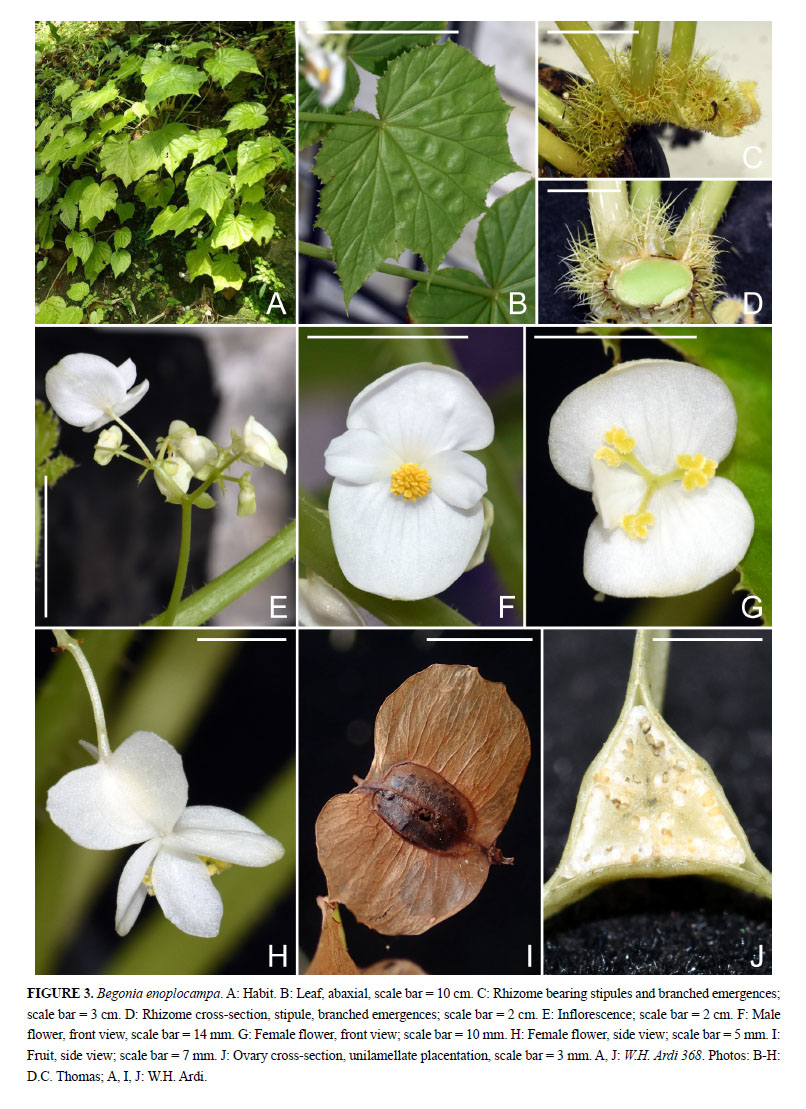Begonia enoplocampa in Phytotaxa 437(2): 81. 2020
Primary tabs

Diagnosis
- The robust, branched, erect emergences on the rhizome and stipules of B. enoplocampa differentiate this species from other species in Begonia section Jackia. (Thomas, D.C. & Ardi, W.H. 2020: Synopsis of Begonia (Begoniaceae) of southwest Sulawesi and the Selayar Islands, Indonesia, including one new species. – Phytotaxa 437(2): 73-96. http://doi.org/10.11646/phytotaxa.437.2.4)
Description
- Perennial, monoecious, rhizomatous herb, up to ca. 40 cm tall. Stem rhizomatous, up to ca. 10 cm long, internodes strongly compressed, densely covered by branched, erect emergences to 1.9 cm long. Leaves alternate; stipules persistent, broadly ovate, asymmetric, 7–10 × 14–16 mm, margin entire, apex rounded, midrib abaxially prominent, forming a subapically emerging, branched bristle 5–15 mm long; petioles 22–37 cm long, terete, green with numerous small whitish dots or stripes, sparsely hairy with multicellular hairs to ca. 2 mm long and microscopic glandular hairs; lamina basifixed, 15–27 × 11–20 cm, broadly ovate, elliptic or suborbicular, asymmetric, margin dentate and denticulate between the larger teeth, often shallowly lobed (to ca. 30% of the lamina width), teeth bristlepointed, base cordate, lobes not overlapping or sometimes slightly overlapping, apex acute, adaxially green, sparsely bristly hairy on veins and lamina, abaxially pale green, sparsely hairy on veins only, venation palmate, primary veins 7–9, actinodromus, secondary veins craspedodromus. Inflorescences: bisexual, protandrous, axillary, dichasialmonochasial cymes, with 3–4 basal dichasial branchings and 1–3 distal monochasial branchings; peduncle 14–27.5 cm long, pale green, sparsely hairy; bracts anisophyllus, ovate to elliptic, 3–5 × 2–3 mm, minute in more distal inflorescence part, sparsely hairy, semi-persistent. Male flowers: pedicels 8–13 mm long, glabrescent, pale greenwhitish; tepals 4, unequal, outer tepals 2, much larger than inner, orbicular to broadly ovate, 8–15 × 10–16 mm, white, margin entire, apex rounded, glabrous, inner tepals 2, obovate to elliptic, 6–10 × 4–6 mm, margin entire, apex obtuse and shortly cuspidate, white; androecium yellow, symmetric, globose; stamens ca. 69–81, free filaments up to ca. 0.5 mm long, fused at the base to a short column, anthers up to ca. 0.5 mm long, dehiscing through laterally positioned slits > ½ as long as the anthers. Female flowers: pedicel 8 mm long, glabrous, whitish; tepals 3, unequal, 2 outer broadly ovate, 7 × 10 mm, margin entire, apex rounded, 1 inner tepal elliptic, 8 × 3 mm, apex acute; ovary (excluding the wings) 6 × 3 mm, ellipsoid, white, turning green at maturity (transition to fruiting), locules 3, placentation axile, placentae entire, wings 3, equal, base convex to subtruncate, apex rounded, cuneate, or subtruncate, widest point 4 mm (at the middle to basal part), style ca. 5 mm long, fused at base, 3–branched, each stylodium bifurcate in the stigmatic region, stigmatic surface a spirally twisted papillose band, yellow. Fruits: dry capsule; pedicels 9–20 mm long; seed-bearing part 7–10 × 5–7 mm (excluding the wings), ellipsoid, wing shape as for ovary, widest point up to 8 mm (middle to basally). Seeds barrel-shaped, ca. 0.3 mm long. (Thomas, D.C. & Ardi, W.H. 2020: Synopsis of Begonia (Begoniaceae) of southwest Sulawesi and the Selayar Islands, Indonesia, including one new species. – Phytotaxa 437(2): 73-96. http://doi.org/10.11646/phytotaxa.437.2.4)
Habitat
- Lowland to hill forest, primary to strongly disturbed habitats, observed on river embankments and invillage gardens, terrestrial in soil or in between and on large volcanic rocks, at ca. 300 to 550 m elevation. (Thomas, D.C. & Ardi, W.H. 2020: Synopsis of Begonia (Begoniaceae) of southwest Sulawesi and the Selayar Islands, Indonesia, including one new species. – Phytotaxa 437(2): 73-96. http://doi.org/10.11646/phytotaxa.437.2.4)
Conservation
- Endangered (EN) B1ab(iii),B2ab(iii). This species is known from only three collections, two from Selayar Island and one from Tanah Jampea, none of which are in a legally protected area. The recent collection and additional observations were made at or near to human settlements on Selayar in areas showing considerable disturbance, and most lowland and hill forest on both Selayar and Tanah Jampea has been converted or is in poor condition (Cannon et al. 2005, 2007). Because of the restriction to two islands and associated small EOO and AOO in combination with observed disturbance and loss of forest habitat in the Selayar Regency, we assess this species as Endangered. (Thomas, D.C. & Ardi, W.H. 2020: Synopsis of Begonia (Begoniaceae) of southwest Sulawesi and the Selayar Islands, Indonesia, including one new species. – Phytotaxa 437(2): 73-96. http://doi.org/10.11646/phytotaxa.437.2.4)
Distribution (General)
- Indonesia; endemic to Sulawesi: South Sulawesi, Selayar Regency (Selayar Island and Tanah Jampea) (Fig. 1A). (Thomas, D.C. & Ardi, W.H. 2020: Synopsis of Begonia (Begoniaceae) of southwest Sulawesi and the Selayar Islands, Indonesia, including one new species. – Phytotaxa 437(2): 73-96. http://doi.org/10.11646/phytotaxa.437.2.4)A
Etymology
- The species epithet is a compound of énoplos (Greek, ένοπλος = weapon, with weapons) and kámpë (Greek, κάμπη = caterpillar) referring to the resemblance of the rhizome to a bristly caterpillar (Fig. 3C, D). (Thomas, D.C. & Ardi, W.H. 2020: Synopsis of Begonia (Begoniaceae) of southwest Sulawesi and the Selayar Islands, Indonesia, including one new species. – Phytotaxa 437(2): 73-96. http://doi.org/10.11646/phytotaxa.437.2.4)B
Notes
- The erect, branched emergences of the rhizomes are unique in section Jackia (Fig. 3C, D). The Sumatran species B. puspitae Ardi (Hughes et al. 2009: 39) and B. halabanensis Hughes (Hughes et al. 2015b: 12) have an indumentum of branched trichomes on their stipules and rhizomes. In both species, these trichomes form a matted, entangled indumentum, however, and the individual hairs are flexible and nowhere as robust as the erect emergences in B. enoplocampa. (Thomas, D.C. & Ardi, W.H. 2020: Synopsis of Begonia (Begoniaceae) of southwest Sulawesi and the Selayar Islands, Indonesia, including one new species. – Phytotaxa 437(2): 73-96. http://doi.org/10.11646/phytotaxa.437.2.4)
Specimens
- INDONESIA. Sulawesi, South Sulawesi: Tanah Tjampea, 12 May 1913, W. Docters van Leeuwen-Reijnvaan 1568 (U); Saleyer, 23 May 1913, W. Docters van Leeuwen-Reijnvaan 1746 (U). (Thomas, D.C. & Ardi, W.H. 2020: Synopsis of Begonia (Begoniaceae) of southwest Sulawesi and the Selayar Islands, Indonesia, including one new species. – Phytotaxa 437(2): 73-96. http://doi.org/10.11646/phytotaxa.437.2.4)

